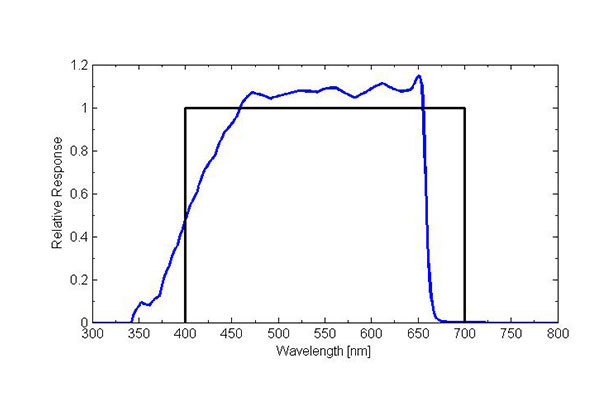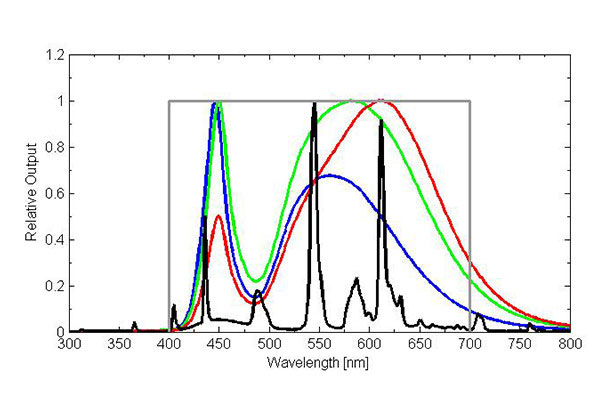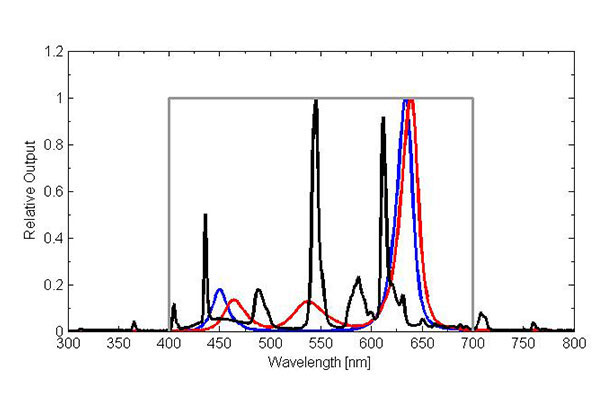发光二极管(LED)的光强度测量
Customers often contact Apogee Instruments to inquire about whether quantum sensors and meters can be used to measure the radiation intensity from light emitting diodes (LEDs), as LEDs are becoming increasingly common as light sources for plant growth in controlled environments and coral growth in aquariums.另一篇文章provided some qualitative information regarding the use of a broadband device (i.e. quantum/PAR sensors or meters) to measure a narrowband radiation source (i.e. many LEDs currently on the market), where it was stated that a spectroradiometer is the best instrument to accurately measure light intensity of LEDs (see the October 5, 2011 post titled ‘Comparisons in Quantum Sensor Output for Different Light Sources’). While this is true, quantum meters can be used to measure LED intensity, and many customers use them for this application. As a result, an estimate of Apogee quantum meter accuracy for measuring LEDs is very practical.
Quantum传感器/仪表设计用于测量400至700nm之间的光子的总数,光合作用辐射(PAR)范围。与量子计(或传感器)相关的误差来自具有与用于校准仪表的源不同的频谱的源的光的光称为光谱误差。出现光谱误差,因为没有量子计完全匹配定义的量子响应,这意味着它们不会响应400nm和700nm之间的所有波长的光。PhoGee量子仪对大约370nm和665nm之间的波长敏感,由于扩散器中使用的蓝色颜料,450nm和650nm之间的相对平坦的响应(图1)。然而,它们对光合作用范围内的波长同样敏感(图1)。为了确定光谱误差,需要测量量子仪,校准光源和光源的光谱响应以及一些依赖的依赖性计算(有关详细信息,请参阅Federer和Tanner,1966; Ross和Sulev,2000)。
用于电照的Apogee量子传感器和仪表在填充T5冷白色荧光灯的定制室中校准。LED具有比T5灯(图2,3和4)具有非常不同的光谱输出,因此,预期某种程度的光谱误差。对于下面所示的窄带,宽带和混合LED,光谱误差为8%或更低。与较长波长相比,Apogee量子传感器和仪表对蓝色波长(近400nm)不太敏感,并在蓝色LED下读取低电平。相反,与蓝波长相比,ApoGee量子传感器和仪表对绿色和红色波长(高于500nm)更敏感,并且在绿色和红色LED下读取高。宽带白光LED输出超过Apogee量子传感器/仪表灵敏度范围(665nm)的上端之外的小比例辐射,并为白光LED产生低测量。
重要说明:输出大部分辐射大约660nm的LED将读取非常低,不应与Apogee原始量子传感器(SQ-100,200,300和400型号)测量,但会很好Apogee全频谱量子传感器(型号SQ-500)。
bob体育竞技Apogee仪器最近在2012年国际受控环境农业会议上介绍了多量子传感器的光谱误差的比较。看到这里海报的PDF。
表格1:Theoretical Spectral Errors for Apogee Quantum Meter Measurements of Multiple LED Sources
| LED | 电动校准错误[%] |
| 蓝色(448 nm峰,10 nm fwhm) | -10.7 |
| Green (524 nm peak, 15 nm FWHM) | 5.8 |
| Red (635 nm peak, 10 nm FWHM) | 4.7 |
| 凉爽的白色 | -4.2 |
| 中性白 | -6.1. |
| 温暖的白色 | -9.9 |
| 红色,蓝色混合物 | 2.7 |
| 红色,绿色,蓝色混合物 | 3.5 |
更多的光酸ce spectral errors and information on how to correct for those errors, visit流行光源的光谱误差以及如何纠正它们。

图1:APOGEE量子传感器/仪表响应(蓝线)与在400nm和700nm之间的所有波长之间的相同敏感度的定义量子响应(黑线)相比。

图2:T5酷白色荧光谱(灯泡用于电光校准量子米;黑线)与窄带彩色LED(蓝色,绿色,红线)和定义的量子响应(灰线)相比。

图3:T5酷白色荧光光谱(灯泡使用的灯泡电光校准量子计;黑线)与宽带白色LED相比(酷白色荧光 - 蓝线,中性白色荧光 - 绿线,暖白色荧光 - 红线)和定义量子响应(灰线)。

Figure 4:T5 cool white fluorescent spectrum (lamp used by Apogee for electric light calibration of quantum meters; black line) compared to mixtures of narrowband color LEDs (red/blue – blue line, red/green/blue – red line) and defined quantum response (gray line).
References
Federer, C.A. and C.B. Tanner, 1966. Sensors for measuring light available for photosynthesis. Ecology 47:654-657.
Ross,J.和M. Sulev,2000.标准率测量的错误来源。农业和森林气象100:103-125。
